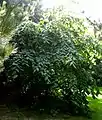Tilia caroliniana
Tilia caroliniana Mill. is a species of tree in the family Malvaceae native to the southern and south-eastern states of the U.S., and Mexico.[2]
| Tilia caroliniana | |
|---|---|
.jpg.webp) | |
| Botanical drawing of Tilia caroliniana subsp. heterophylla. | |
| Scientific classification | |
| Kingdom: | Plantae |
| Clade: | Tracheophytes |
| Clade: | Angiosperms |
| Clade: | Eudicots |
| Clade: | Rosids |
| Order: | Malvales |
| Family: | Malvaceae |
| Genus: | Tilia |
| Species: | T. caroliniana |
| Binomial name | |
| Tilia caroliniana | |
| Synonyms[1] | |
| |
Taxonomy
T. caroliniana consists of 4 subspecies:[2]
- T. caroliniana subsp. caroliniana
- T. caroliniana subsp. floridana Small (E. Murray)
- T. caroliniana subsp. heterophylla (Vent.) Pigott)
- T. caroliniana subsp. occidentalis (Rose) Pigott)
Trees described as belonging to Tilia mexicana, belong to either subsp. floridana or subsp. occidentalis.[2] However, the taxonomy of American species of Tilia remains a matter of contention. DNA analysis, which has clarified much of the taxonomy of genera such as Ulmus, has yet to be applied to Tilia. Pigott (2012) wrote:[3]
The complexity of variation in American Tilia is not readily treated by classical taxonomy, and attempts to do so have resulted in the description of a profusion of species and varieties that are often separated by small and inconsistent differences.
Description
Tilia caroliniana may grow to 30 m (98 ft) tall with a trunk up to 150 cm (4.9 ft) in diameter. The leaves are large, very unequal at the base, 7–19 cm (2+3⁄4–7+1⁄2 in) long and 6–14 cm (2+1⁄4–5+1⁄2 in) broad, with a finely toothed margin; they are light green and smooth above, and silvery downy beneath.[4] Some leaves on specimens identified as T. mexicana in English arboreta are huge, 30 cm (0.98 ft) long,[5] as exemplified by the specimen at the Ventnor Botanic Garden. The flowers, larger than those of T. americana, are produced in clusters of 10–24 together. The fruit is spherical, 13 mm (1⁄2 in) diameter, downy, with the fruit bract pointed at the base.[4][2]
 Tree accessed as T. mexicana at Ventnor Botanic Garden, Isle of Wight
Tree accessed as T. mexicana at Ventnor Botanic Garden, Isle of Wight Typical leaf
Typical leaf Foliage of specimen, at Ventnor B. G.
Foliage of specimen, at Ventnor B. G. Large leaf, >30 cm long
Large leaf, >30 cm long Flowering T. caroliniana subsp. heterophylla
Flowering T. caroliniana subsp. heterophylla
Uses
The young leaves are edible, and can be made into a mild-flavored tea.[6]
Cultivation
Seed of Mexican specimens collected by the British 1991 expedition in the Sierra Madre Oriental has yielded trees which are 'growing steadily' in British gardens, including on heavy clay. The species is currently (2017) in commerce in the UK.[7]
Notable trees
In the UK, the TROBI champion, identified as T. mexicana, grows at Wisley, where it had attained a height of 8 m and a d.b.h. of 17 cm by 2010.[8]
The record-holding tree is located on the campus of Radford University in Virginia.
References
- Royal Botanic Gardens, Kew and Missouri Botanical Garden. (2013). The Plant List. Version 1.1
- Pigott, Donald (2012). Lime-trees and Basswoods: A Biological Monograph of the Genus Tilia. Cambridge University Press. pp. 267–292. ISBN 9780521840545.
- Pigott, Donald (2012). p.253
- LaFarge, Timothy (1990). "Tilia heterophylla". In Burns, Russell M.; Honkala, Barbara H. (eds.). Hardwoods. Silvics of North America. Washington, D.C.: United States Forest Service (USFS), United States Department of Agriculture (USDA). Vol. 2 – via Southern Research Station.
- Hillier & Sons. (1990). Hillier's Manual of Trees & Shrubs, 5th ed.. David & Charles, Newton Abbot.
- Plants For A Future: Tilia heterophylla
- International Dendrology Society. Tilia mexicana. Trees and Shrubs online. [1]
- Johnson, O. (ed.). (2011). Champion Trees of Britain & Ireland. Royal Botanic Gardens, Kew, London. ISBN 978-1842464526